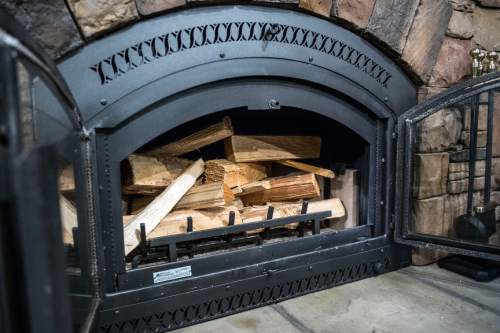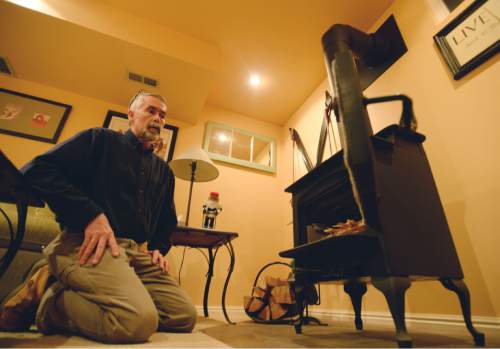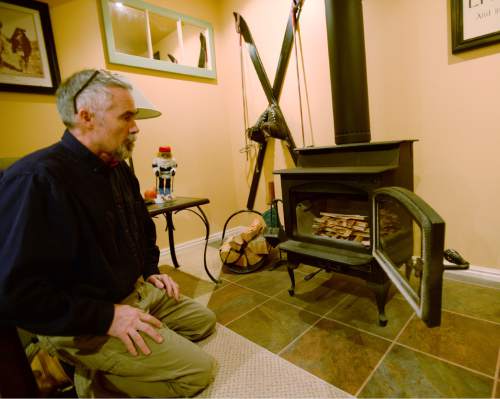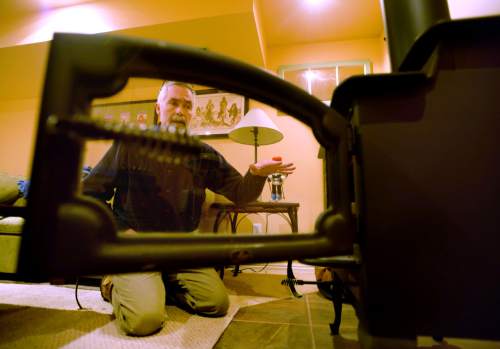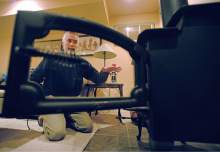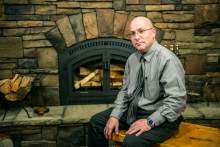This is an archived article that was published on sltrib.com in 2015, and information in the article may be outdated. It is provided only for personal research purposes and may not be reprinted.
A few years ago, Scott Thomas dropped $3,500 on a new wood-burning stove.
Convinced by the promise the heater would be 90 percent more efficient than clunky older models, Thomas put the stove in his basement to help heat his home in Salt Lake City's Sugar House neighborhood.
"We haven't had a fire in the fireplace since we put it in," he said.
Thomas is among dozens of Utah homeowners who have installed cleaner-burning wood appliances as the Wasatch Front's perennial inversions increase pressure on those who burn to heat their homes.
But those stove owners worry their investment could go up in smoke if state environmental regulators ban winter-time burning along the Wasatch Front and in the Cache Valley.
Now the $190 million stove industry — and individual buyers — are pushing back as the Utah Air Quality Board gathers public comment on the proposed ban. At meetings in Tooele and Salt Lake City, representatives of the industry hauled new-and-improved stoves to the hearings for ad hoc demonstrations. And a new advocacy group — Utahns for Responsible Burning — has formed.
"We feel clean air and burning responsibly are not mutually exclusive," said John Mortensen, a Salt Lake City stove wholesaler.
Taking a page from the California-based Hearth, Patio and Barbecue Association, the group is asking DEQ to exempt wood-burning appliances that have earned the U.S. Environmental Protection Agency's stamp of approval — a so-called "two-stage" ban, like those in Colorado, New Mexico and California.
"If you have the right equipment and know how to use it, you can burn without much of an impact on air quality," Thomas said. "It would make sense to do some kind of permit for people who have an updated wood stove to use it on green days. That would be harder to enforce, but if other communities have figured it out, I don't see why we can't."
Public health advocates and air quality watchdogs counter that even the cleaner stoves are not clean enough. They still put off carcinogens and pollution precursors that endanger homeowners' health and the health of their neighbors.
Wood smoke accounts for 5 percent of the Wasatch Front's particulate pollution. For many, wood burning — in any device — is not acceptable in urban areas, especially in Utah's population centers, which struggle with high levels of fine particulate pollution throughout the cold winter months.
A cleaner business model
In pollution-conscious modern America, stove industry executives and individual retailers see technology as their economic salvation.
New-and-improved stoves and fireplace inserts use catalytic conversion, or secondary burning, to essentially eliminate visible smoke after they warm up and if they are used properly.
"Smoke is tiny particles of unburned fuel. If you capture that and burn it, everyone is happy. There's more heat produced and less smoke going in the air," said Bruce Bugbee, a Utah State University professor of plant physiology. He heats his Logan home with a catalytic-equipped stove.
Catalytic stoves direct smoke and air through a mesh box composed of tiny tubes coated with noble metals, such as palladium. In the presences of the catalysts, the temperature required for combustion drops from about 1,200 degrees Fahrenheit to around 500 degrees, according to Mortensen. Such stoves emit as much as 90 percent less pollution than their predecessors, which were little more than a simple steel box with a hole on top.
The Lopi Parlor stove Scott Thomas bought is non-catalytic, deploying baffles for secondary combustion. Air flow through the stove pushes smoke across the roof of the fire box where it ignites as it passes tubes that shoot out preheated air.
"Smoke gets on a longer path, keeping it in the stove longer," Mortensen said. "Two-thirds of the energy in that wood is in smoke and that's what you want to burn."
New stoves also are vastly more efficient.
"You can use one-third to one-half as much wood," he said. "If you put in a lot less fuel, there will be a lot less smoke coming out, whether you're talking [nitrogen oxides], [sulfur oxides] [volatile organic compounds], whatever."
The cost of installing the high-tech stoves ranges from $2,000 to $6,000, according to John Crouch, spokesman for the Hearth, Patio and Barbecue Association.
A two-stage restriction — the industry's preference — still would ban open burning, wood fireplaces and older, higher-emitting stoves. But Utahns like Bugbee and Thomas, who have installed new EPA-certified stoves, would be exempt.
Utah Division of Air Quality officials believe there are about 183,000 wood stoves operating in the seven northern Utah counties affected by burn restrictions. Only about 23,000 are EPA-certified.
Each year, the industry sells on average 170,000 EPA-certified appliances that burn either logs or sawdust compressed into pellets, according to Crouch.
"The real challenge is to change out the 6 million old uncertified stoves [nationwide] and move these people to cleaner forms of wood heat," he said.
A two-stage restriction in Utah, he acknowledges, could be good for business.
"Our goal is to reduce smoke by getting people to do a better job heating with wood," Crouch said. "It still restricts burning for pleasure and restricts burning in old uncertified stoves, which are the majority. And it honors those people who have tried to do the right thing."
Not clean enough
State regulators and environmental advocates question some of the industry's claims about the new stoves.
The EPA tests the appliances under ideal conditions that are not always replicated in the real world, critics say. Testers use well-seasoned Eastern hardwoods cut to optimal log lengths and monitor emissions when the stoves are operating at peak performance.
And the cleaner stoves still emit far more pollutants than a well-functioning gas furnace, Division of Air Quality scientists say. The process of eliminating visible smoke can create other pollutants.
"When you control for particulate, NOx emissions go up," said Dave McNeill, the agency's planning director.
Nitrogen oxides are gases that recombine into particulates after they are released into the atmosphere. Regulators believe such "secondary" particles represent two-thirds of Utah's air pollution muck.
In support of the proposed winter-long ban, DAQ points to recent research that shows 5 percent of the direct particulate pollution recovered on Salt Lake City's air-monitoring filters comes from wood smoke.
But Bugbee notes that data was recorded prior to 2012, when DAQ implemented tougher restrictions that restrict wood burning days before air quality reaches unhealthy levels.
"We have done a lot to reduce wood burning on inverted days in the last four years, but we don't have a study to show how we are doing now," he said.
Regardless, clean air advocates say, the industry's claims of "cleaner" stoves are misleading. One activist likens the proposed exemption for newer stoves to saying "cigarettes should be allowed on airplanes — as long as they're filtered.
"EPA wood stoves have never been shown under any circumstance to reduce the amount of the most deadly components of wood smoke, like dioxins, furans, and PAHs," or polycyclic aromatic hydrocarbons, said Brian Moench of Utah Physicians for a Healthy Environment. "Wood smoke disperses poorly such that it creates hot spots so that immediate neighbors are subject to levels that are off the charts."
An outlier
But the ban on burning that Moench champions is hardly the norm across the West.
According to Hearth industry spokesman Crouch, no state has gone as far as Utah is now proposing to do. Most states give cleaner-burning appliances some consideration and provide incentives to change out old units.
For example, Colorado exempts approved stove models from burn restrictions imposed on polluted days in the Denver metro area. That means a Denver resident can burn in an EPA-certified appliance, even on the most polluted days.
Albuquerque, Seattle and central California's San Joaquin Valley also apply two-stage restrictions, Crouch said.
For EPA certification, stove and insert models must put off less than 7.5 grams of particulate pollution in an hour. Catalytic stoves are required to emit even less.
EPA currently is revising its 23-year-old standards and the process by which units are certified.
"The proposed updates would strengthen the emissions standards for new wood stoves, while establishing federal air standards for several other types of new wood heaters," EPA spokeswoman Enesta Jones wrote in an e-mail. "To strengthen compliance assurance and consumer confidence, the proposed standards would require testing and certification by internationally accredited laboratories and certification bodies."
A final EPA rule is due Feb. 3.
Devil's in the details
If state regulators concede to industry and consumer pressure, and implement a two-stage ban, critics say the optimal conditions the EPA achieves for measuring a stove's pollution are unlikely to be replicated by everyday users in Utah.
Stove owners often tamp down their fires at night, for example, choking back air and reducing the stoves' efficiency, Moench said. And catalytic combustors wear out after seven to 15 years and cost $150 to $300 to replace.
Moench argues it's unrealistic for the state to expect stove owners to replace worn-out catalytic units.
But industry representatives say an exemption to the rules can be tailored to require stove owners to maintain functioning pollution controls and proper burning.
"It's not hard to enforce," Crouch said. "If you see smoke [after 20 minutes] you send them a notice of violation. It's not rocket science."
Public hearings resume in Ogden and Brigham City on Tuesday.
Twitter: @brianmaffly


